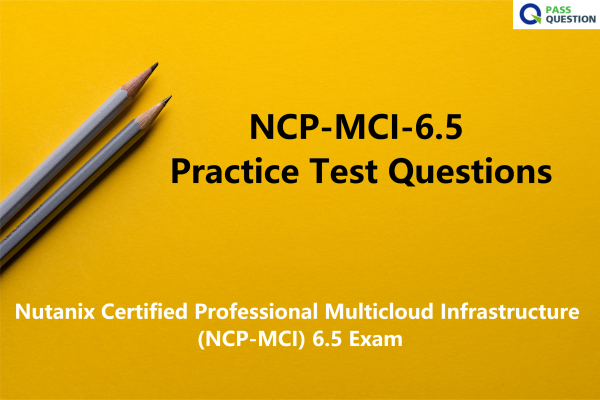NCP-MCI-6.5 Practice Test Questions - Nutanix Certified Professional Multicloud Infrastructure (NCP-MCI) 6.5 Exam
Passing the NCP-MCI-6.5 Nutanix Certified Professional Multicloud Infrastructure (NCP-MCI) 6.5 Exam requires a good understanding of the subject and a lot of hard work. To help you prepare for the exam, we have created a set of NCP-MCI-6.5 Practice Test Questions which are designed to test your knowledge and skills in all the key areas covered in the NCP-MCI-6.5 certification exam. With the NCP-MCI-6.5 Practice Test Questions, you will get a feel of the actual exam environment and be able to identify the areas where you need improvement. By using the NCP-MCI-6.5 Practice Test Questions, you can boost your confidence and increase your chances of passing the NCP-MCI-6.5 exam on the first attempt.

Nutanix Certified Professional Multicloud Infrastructure (NCP-MCI) 6.5 Exam
The Nutanix Certified Professional - Multicloud Infrastructure (NCP-MCI) certification validates your skills and abilities to complete routine tasks, including deploying and managing virtual infrastructure components and VMs, performing operational maintenance tasks, and initiating disaster recovery. Additionally, the exam validates your ability to configure user roles and remediate infrastructure alerts and events. It is recommended that candidates have the knowledge and skills necessary to deploy, administer and troubleshoot a Nutanix AOS environment before attempting the NCP-MCI 6.5 exam.
Exam Information
Format: 75 multiple choice questions
Time Limit: 120 minutes
Language: English and Japanese
Pricing: $199 per attempt
Passing Score: 3000 (1000-6000)
Knowledge Objectives
Section 1 – Manage Cluster, Nodes, and Features
- Perform initial cluster configuration tasks
- Manage supporting infrastructure tasks
- Upgrade the platform using Life Cycle Manager (LCM)
- Maintain a Nutanix cluster
- Manage user roles and permissions
Section 2 – Manage Cluster Storage
- Manage node operations in a Nutanix cluster
- Describe Nutanix storage concepts
- Configure Nutanix storage optimization features
Section 3 – Configure Cluster Networking and Network Security
- Deploy and configure networking
- Describe Nutanix networking concepts
- Given a scenario, troubleshoot basic cluster networking
Section 4 – Analyze and Remediate Performance Issues
- Determine how to use reporting tools
- Given a scenario, determine which metrics and entities are relevant
- Given a scenario, interpret anomaly detection events
- Determine how to resolve a performance issue
- Identify VM inefficiencies
Section 5 – Configure, Analyze, and Remediate Alerts and Events
- Configure Remote Syslog Server settings
- Identify common Nutanix services
- Configure Nutanix alert policies
Section 6 – Manage VM Deployment and Configuration
- Create, modify, and optimize VMs and their components
- Manage the image service
- Describe VM storage policies
- Manage VM placement options
View Online Nutanix Multicloud Infrastructure NCP-MCI-6.5 Free Questions
1. Which node type does not deploy a Nutanix Controller VM?
A.Storage Only
B.Hyper Converged
C.Compute Only
D.All Flash
Answer: C
2. An administrator notices that most of the VMs in the cluster are on one host. Users report that an application seems to respond slowly. The application server VM has significantly more memory assigned to it than other VMs.
How should the administrator fix this issue?
A.Reduce the amount of memory assigned to the VM.
B.Migrate the VM to a different host.
C.Add more memory to the VM.
D.Increase the memory on the CVM.
Answer: B
3. A guest VM should be able to tolerate simultaneous failure of two nodes or drives.
What are the minimum requirements for the Nutanix cluster?
A.3 nodes with cluster RF 3 and container RF 3
B.3 nodes with cluster RF 3 and container RF 2
C.5 nodes with cluster RF 2 and container RF 3
D.5 nodes with cluster RF 3 and container RF 3
Answer: D
4. What Nutanix feature provides effective caching optimization In VDI environments?
A.Remote Protection Group
B.Local Protection Group
C.Snap Clones
D.Shadow Clones
Answer: D
5. An administrator is configuring data protection and DR for a multi-tier application. All VMs must be protected at the same time.
What must the administrator do to meet this requirement?
A.Create a consistency group for each VM with identical schedules
B.Create a consistency group for the application and place all VMs in it
C.Create a protection domain for the application and select auto-protect related entities
D.Create a protection domain for each VM with identical schedules
Answer: B
6. In Nutanix clusters, which feature ensures VMs can be migrated and restarted on another host in case of failure?
A.High Availability
B.Protection Domain
C.Host Affinity Rules
D.Availability Zone
Answer: A
- TOP 50 Exam Questions
-
Exam
All copyrights reserved 2025 PassQuestion NETWORK CO.,LIMITED. All Rights Reserved.

